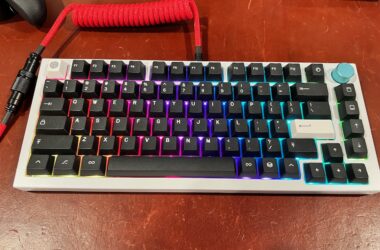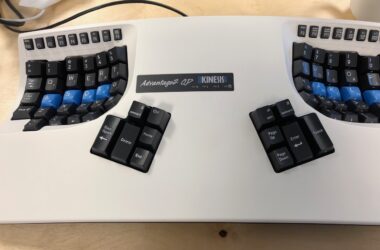This post on keyboards had been sitting in my drafts folder for a month, but I never got around to finishing it. Here’s part 1, which should motivate me to write part 2.
I’ve now spent over a month typing on the Kinesis Advantage keyboard. It’s a keyboard that a friend of mine swears by, but I’ve never really been keen on specialty keyboards, particularly those that substantially deviate from the standard key layout. However, I got excited by the Keyboard.io kickstarter1, which prompted me to try the Kinesis and its emphasis on typing with thumbs over pinkies.
The Persistence of Keyboards
Ever since I started buying my own computing hardware, I’ve tried to maximize their quality of input and output. While my friends spent money on faster CPUs and fancier sound cards2, I thought that we didn’t devote nearly enough time bettering our peripherals. Interfaces matter, and my computing experience would still be worsened with poor speakers and shoddy displays and inaccurate mice.
Keyboards are definitely under-appreciated. Most PCs throw in a $5 plastic monstrosity and users remain content with basic keyboards. Touch devices have standardized on virtual keyboards, and they’re merely serviceable; we’ve accepted having our thumbs tap out keys to a layout that was designed for 10 fingers. That said, we still end up using keyboards as it continues to be the most efficient way to enter complex input.
Speech-to-input may eventually take over as the preferred way to control our devices, but the keyboard will still be around for the foreseeable future.
Searching for Better Ergonomics
Since coding and writing require spending a lot of time on the keyboard, I wanted to find ways to improve on typing itself. I had been touch typing since a teenager, so beyond improvements in raw WPM, I wanted to find better design in both key and keyboard layouts. Ergonomics and efficiency were my primary drivers.
To address the former issue, I took up the Dvorak key layout. To be completely honest, I don’t really know whether it has made a huge difference in efficiency: both the knock against QWERTY’s design origins and Dvorak’s efficiency gains have been questioned in recent years. For me, it was a handful of months of painful adaptation, and while I now have trouble typing at full speed with a QWERTY layout, I’m actually a little slower in WPM now than before the switch3.
To the latter issue of physical keyboard layouts (i.e., the general shape of the keyboard, not just where each key resides)4, there are a good number of keyboards that offer contoured shapes beyond the standard flat 2-by-4 board. The Microsoft Natural Ergonomic Keyboard 4000 has been the industry standard for 15+ years, and their replacement – the Microsoft Sculpt Ergonomic Keyboard – has been great as well. The Kinesis Advantage keyboard gets into that specialized keyboard territory in both price and form.
More on what makes Kinesis expensive next post!
Which I ultimately passed on, as I was already getting used to the Kinesis Advantage.↩
Yes, there was a decade in computing when consumer-grade audio processing mattered.↩
There are more alternative keyboard layouts with purported efficiency benefits, but they’re even more niche than Dvorak and implementations are hard to come by.↩
Though there was also a period when I incorrectly concluded that gaming keyboards – which typically dedicate keys to macros – would be sufficient.↩




